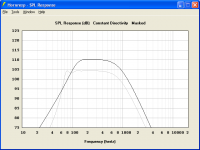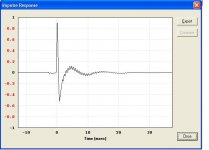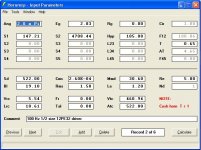Is that because he made a mistake in the spreadsheet? The mouth areas are the same, the throat areas are close, but only the length is different. I used the system designer tool in Hornresp to build the horn there.
Hi dirkwright,
It seems that there may be an error in the spreadsheet methodology.
For Placement = 4, the mouth area is divided by 4 as expected, but the new length is calculated assuming that the truncated mouth is fully formed, which is not really the case. This questionable assumption means that the profile cutoff frequency becomes 120 hertz rather than the required 60 hertz - which explains why the spreadsheet horn is shorter than it should be.
Spreadsheet:
Fc = 60 Hz
Placement = 4
At = 178.8 sq cm
Am = 6539.5 sq cm
Length = 68.43 cm
Hornresp:
S1 = 178.80 sq cm
S2 = 6539.49 sq cm
L12 = 68.42 cm
F12 = 120 hertz
Note that when Fc is changed to 120 hertz in Hornresp, the results become the same - allowing for the slight differences in mouth area and length due to rounding, as mentioned previously.
Kind regards,
David
Hi dirkwright,
Have a look at the formula in the spreadsheet used to calculate Rm (mouth radius). The velocity of sound value used here is 340 m/sec. Change this to 344 m/sec and you will now get effectively the same results as those calculated by Hornresp - allowing for the very slight differences in mouth area and length due to rounding.
Spreadsheet:
Fc = 60 Hz
Placement = 1
At = 178.8 sq cm
Am = 26158.0 sq cm
Length = 199.63 cm
Hornresp:
S1 = 178.80 sq cm
S2 = 26157.99 sq cm
L12 = 199.62 cm
F12 = 60 hertz
Kind regards,
David
Holy Crap!!!!! Thank you thank you thank you!!!!

Erik made a mistake !!!!
Erik made a mistake !!!!
THem who make no things make no mistakes!
Hi dirkwright,
It seems that there may be an error in the spreadsheet methodology.
For Placement = 4, the mouth area is divided by 4 as expected, but the new length is calculated assuming that the truncated mouth is fully formed, which is not really the case. This questionable assumption means that the profile cutoff frequency becomes 120 hertz rather than the required 60 hertz - which explains why the spreadsheet horn is shorter than it should be.
Spreadsheet:
Fc = 60 Hz
Placement = 4
At = 178.8 sq cm
Am = 6539.5 sq cm
Length = 68.43 cm
Hornresp:
S1 = 178.80 sq cm
S2 = 6539.49 sq cm
L12 = 68.42 cm
F12 = 120 hertz
Note that when Fc is changed to 120 hertz in Hornresp, the results become the same - allowing for the slight differences in mouth area and length due to rounding, as mentioned previously.
Kind regards,
David
Thanks again David! You've been very helpful. I still can't believe this software is free!

Thanks again David! You've been very helpful.
Hi dirkwright,
You're welcome
It is interesting how the (corrected) spreadsheet assumes that a tractrix horn having S1 = 178.80, S2 = 6539.49 and L12 = 68.42 radiating into 1Pi space will have a performance comparable to a tractrix horn having S1 = 178.80, S2 = 26157.99 and L12 = 199.62 radiating into 4Pi space.
As can be seen from the attachment, a quick check in Hornresp shows that this is clearly not the case - the black trace shows the response for the 1Pi horn and the gray trace shows the response for the 4Pi horn.
Kind regards,
David
Attachments
Thanks again for your analysis David. I'm very impressed with your enthusiasm. I just have one question about your program. Why is it not possible to increase the window size? I assume this is intentional, but don't know why.
Once I get some other projects out of the way, I'll be building a 1/2 size 100Hz hyp-ex straight horn using data from your program. You've made a huge contribution to horn loudspeaker design. You should be very proud of your accomplishment.
Once I get some other projects out of the way, I'll be building a 1/2 size 100Hz hyp-ex straight horn using data from your program. You've made a huge contribution to horn loudspeaker design. You should be very proud of your accomplishment.
I was modeling a TL enclosure and wanted to mess around with multiple drivers so I changed the number of drivers but nothing changed. In the same size line I got the same response and the same max SPL. Increasing the size of the line (cross section) changed the response in the same way as for a single driver. What am I neglecting? I wanted to model 8 10" drivers connected in series (there is a reason for this).
I would think "n" drivers would require a cross section "n" times that of a single driver no?
I would think "n" drivers would require a cross section "n" times that of a single driver no?
Hmm, when I double up drivers it dramatically changes the response, turning a highly under-damped TL to over-damped and increasing its Xmax limited BW +6 dB at its minimum frequency just as it should.
Correct, to maintain the same response the cab's net Vb must increase by however many drivers there are, so if one driver requires 100 cm^2, then eight require 800 cm^2, though you have to manually change the values in the appropriate fields as it won't auto add like some programs.
GM
Correct, to maintain the same response the cab's net Vb must increase by however many drivers there are, so if one driver requires 100 cm^2, then eight require 800 cm^2, though you have to manually change the values in the appropriate fields as it won't auto add like some programs.
GM
Yes, that is how I expected it to act however in my case the only thing that changes is the grey 8s shows up in the ND field. No change in the results when I run the sim though. Maybe I should try with just two drivers and see what happens. Maybe I am just exceeding some internal limit.
Not sure what you're telling me, but you add drivers using the 'driver arrangement' tool for multiple drivers, then use the 'combined response' tool. I had no problem doing eight drivers [4s+4p], though it did warn me that Sd was 16x larger than S1. 10+10 gave me a '9 in series' limit error, but when I tried nine in series it gave me a runtime error I didn't have time to read before it shut down HR, so something's amiss in River City...........
If you mean you're simming one speaker and using the 'multiple speakers' tool in the SPL response window, then it adds it all, so the only real difference in the plots would be how all the mutual coupling affects its response which may, may not be all that obvious.
GM
If you mean you're simming one speaker and using the 'multiple speakers' tool in the SPL response window, then it adds it all, so the only real difference in the plots would be how all the mutual coupling affects its response which may, may not be all that obvious.
GM
Does anyone know what causes this ringing in the impulse response? How do I get rid of it?
IIRC it has to do with reflections back to the throat, so only an infinite horn can be completely damped without 'cheating' a bit.
GM
IIRC it has to do with reflections back to the throat, so only an infinite horn can be completely damped without 'cheating' a bit.
GM
OK, but I didn't have them when I was playing with another horn. This is a hyp-ex. I can't duplicate my previous results now that didn't have any ringing. dang it.
Last edited:
I was going to say that none of the tractrix I've simmed for others [only one built AFAIK] were ring free, though don't recall ever seeing an impulse measurement of one, so don't know how well they actually do.
Regardless, it's no big deal, damping the mouth or using a foam plug like Dr. Geddes promotes works well enough.
GM
Regardless, it's no big deal, damping the mouth or using a foam plug like Dr. Geddes promotes works well enough.
GM
Why is it not possible to increase the window size?
Hi dirkwright,
Because I like to keep things as simple as I can
Kind regards,
David
Does anyone know what causes this ringing in the impulse response?
Hi dirkwright,
Could you please post a copy of the loudspeaker system input parameters. Thanks.
Kind regards,
David
I was modeling a TL enclosure and wanted to mess around with multiple drivers so I changed the number of drivers but nothing changed.
Hi Mike,
Could you please post a copy of the loudspeaker system input parameters. Thanks.
Kind regards,
David
but when I tried nine in series it gave me a runtime error
Hi GM,
Nine drivers connected in series should work just fine.
I think it must be your weird computer playing up again
Kind regards,
David
Hi dirkwright,
Could you please post a copy of the loudspeaker system input parameters. Thanks.
Kind regards,
David
There you go. I used your system designer. As far as I know the driver parameters are accurate. It's a B&C 12PE32. The horn is a 1/2 size 100Hz hyp-ex.
Attachments
I was going to say that none of the tractrix I've simmed for others [only one built AFAIK] were ring free, though don't recall ever seeing an impulse measurement of one, so don't know how well they actually do.
Regardless, it's no big deal, damping the mouth or using a foam plug like Dr. Geddes promotes works well enough.
GM
Do you damp the mouth with shag carpet like Bruce Edgar once suggested?
- Home
- Loudspeakers
- Subwoofers
- Hornresp


